Enchanting Vat Phou Temple Reveals Hidden Aspects of Laos’ History
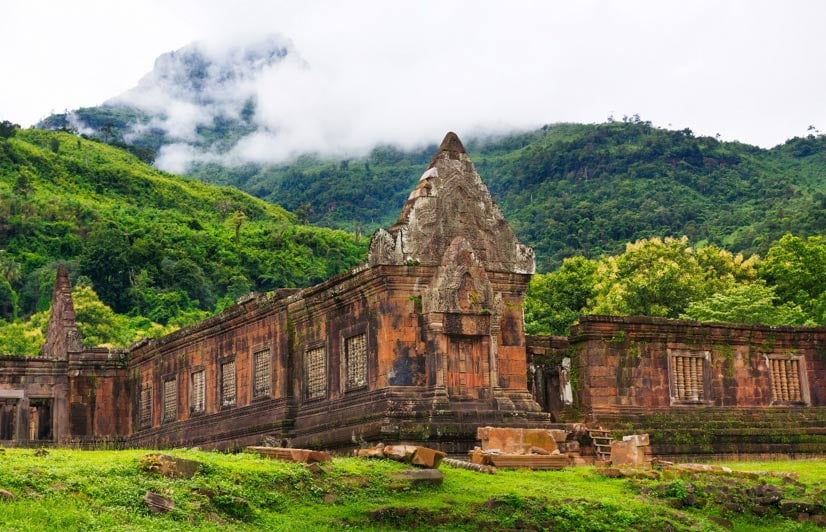
Laos is a country that we know little about, it is only in recent years that the nation has opened to the outside world. But the country has many important archaeological sites, amongst the most renowned in Southeast Asia. One of the most significant and important is Vat Phou, the ruins of a Khmer Hindu temple complex, which has been designated as a UNESCO World Heritage site.
The Sacred Khmer Temple
Based on archaeological evidence there was a temple on the site, which is on a mountain, since the 5 th century AD. At this time, the region came under the cultural and religious influence of India. Vat Phou was associated with the Chenla or Champa kingdom. The temple was not far from the important city of Shrestapura, which is now a ruin.
It is believed that the site was considered holy because of a lingam shaped hillock on the Phou Khao mountain. This meant that the site became associated in the minds of the locals with the Hindu god Shiva. As a result, the temple is dedicated to Shiva.
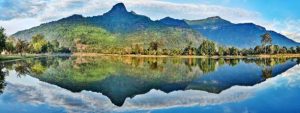
Sacred lingam-shaped Phou Khao mountain reflects in the baray (irrigation pond) of the Vat Phou temple complex. (Dmitry Volochaev / Adobe stock)
The Khmer empire dominated the area from at least the 10 th century. They built a new city to the south of Vat Phou, and later they rebuilt the religious complex, which involved its conversion to Theravada Buddhism, which was the official religion of the Khmer empire.
Following the collapse of the Khmers, the area was settled in by the Lao people who came from the north, and they continued to worship at the temple in the same manner as the Khmers. This temple is still a place of worship, and every year a festival celebrating the arrival of the Lao people in the area is held. Vat Phou is unique being both a major tourist site and religious center.
Take Mystical Journey Through Vat Phou
The temple is set in a forested area at the base of a mountain. It is surrounded by a series of barays or water reservoirs, which were used by the Khmers to support their intensive agriculture in the area. There are several causeways between the barays, and they allow access to the temple complex, which is oriented towards the southeast.
Adjacent to the holy site are two palaces, which have courtyards, and are known as the north and the south palace. The palaces are built in the early Angkor Wat style. The temple is on an escarpment and it can be accessed by a flight of stone steps.
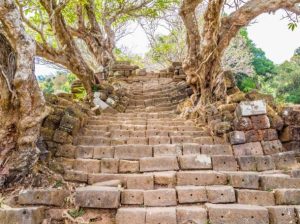
Stairway to Vat Phou, Laos. (Takashi Images / Adobe stock)
There is also a sanctuary dedicated to Shiva. The façade of the shrine is badly weathered and is roofless. However, its lintels are very ornate with scenes from the life of Shiva. At the front of the sanctuary are four images of Buddha. At the back of the sanctuary is a room that once held a lingam that was constantly bathed in water, which was channeled into the room from a nearby spring. Today, a modern image of the Buddha can be seen in the shrine.
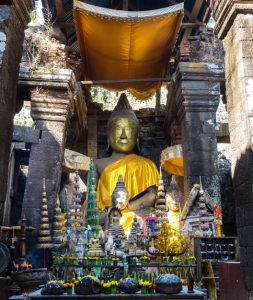
Buddha statue inside the sanctuary at Vat Phou, Laos. (rudiernst / Adobe stock)
To the east of the shrine is a library, which is a semi ruin. Progressing from the shrine, there are several terraces and courtyards. There is a rock relief representing the triple supreme divinities in Hinduism, which is known as the Trimurti. Here the remains of a small Nandi shrine can be seen. The Nandi shrine is known as the gatekeeper of Shiva’s abode. This is a roofless building on a platform that was recently partially restored.
Once there was a road directly to the Khmer capital, Angkor Wat, which began at this location. On the slopes above the temple complex is a footprint of Buddha and a crocodile relief sculpture, which may have marked a place where people were sacrificed before the coming of Buddhism.
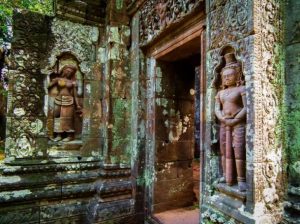
Ancient sculpture carvings at Vat Phou, Laos. (Jack /Adobe stock)
How to Visit Vat Phou?
There are organized tours available to the site, which can be pre-booked. It is also possible to hire motorbikes and visit the temple independently. An admittance fee is required to enter, and a tour guide can be hired. There is plenty to see here, and there are also some important Khmer ruins nearby that can also be visited. Vat Phou has not been fully restored and in general is not in good condition, however, the natural scenery is stunning.